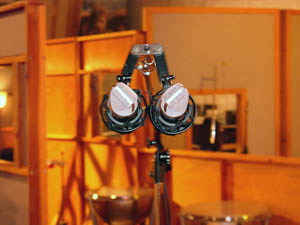Stereo Miking is the use of a matched pair of microphones to capture a single source in a stereo field. The source could be anything from a single instrument to a symphony orchestra. The beauty of a well executed stereo recording is that it preserves the left-right panorama, the balance between the instruments, and the depth of field. While stereo miking has grown out of classical work, it can be very useful for any style of recording.
- Drum overheads
- Acoustic piano
- Percussion
- Backing vocals
- Horn sections
- String ensembles
- Choral groups
- Ambiance
- Location recording for film or TV
Stereo miking techniques fall generally into two categories: coincident (one mic right next to the other) or spaced. Coincident pairs are generally more accurate but subtle, spaced pairs tend to be more dramatic. Engineers often record a combination and adjust the balance in the mix.
The simplest coincident technique is the X-Y, which is accomplished by placing the mics at a 90 degree angle to each other, with one capsule stacked on top of the other.This gives a very realistic stereo image and is mono-compatible, meaning that the two signals will combine without any phase problems (see 5. Phase Issues above). Several well-known stereo mics are built in this fashion, among them the AKG C-24 and the Royer SF-12 and SF-24. Other coincident techniques include Blumlein, ORTF, and M-S (mid-side). While Blumlein and ORTF have their uses, M-S is very popular among engineers. M-S is done with a mic facing the middle of the source, with a bidirectional mic aiming to the sides. This produces left- and right-channel signals. With this technique, the stereo spread can be remote-controlled by varying the ratio of the mid signal to the side signal. The discreet signals can be recorded separately and balanced in the mix, giving the engineer control over the apparent placement of the mic. This remote control is also useful at live concerts, where you can’t physically adjust the microphones during the concert. MS localization accuracy (the realism of the stereo image) is excellent.

Spaced stereo miking can be done with a pair of omni or cardiod mics placed at a distance of roughly 1/2 to1/3 the width of the sound field. While not as accurate as coincident pairs, spaced pairs give a dramatic stereo spread which can be very useful. Engineers often record drum room ambiance this way, to be mixed in with the close mics, giving the kit its size. Spaced omnis are often used for recording orchestras, either alone or mixed with a coincident pair to add width. A variation on the spaced pair is the Decca Tree, which adds a center mic to a pair spaced approximately 80″ apart on a large T-shaped bar. This method is very popular in film and TV scoring, thanks to the post-recording control of the center channel.
For those interested in learning more about stereo miking techniques, volumes have been written and are readily available in books and on the Internet.